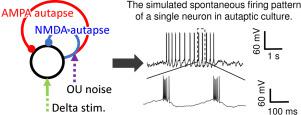Biosystems ( IF 2.0 ) Pub Date : 2020-10-17 , DOI: 10.1016/j.biosystems.2020.104278 Kouhei Hattori 1 , Takeshi Hayakawa 2 , Akira Nakanishi 1 , Mihoko Ishida 1 , Hideaki Yamamoto 2 , Ayumi Hirano-Iwata 3 , Takashi Tanii 1

|
Single neurons in an autaptic culture exhibit various types of firing pattern with different firing durations and rhythms. However, a neuron with autapses has often been modeled as an oscillator providing a monotonic firing pattern with a constant periodicity because of the lack of a mathematical model. In the work described in this study, we use computational simulation and whole-cell patch-clamp recording to elucidate and model the mechanism by which such neurons generate various firing pattens. In the computational simulation, three types of spontaneous firing pattern, i.e., short, long-lasting, and periodic burst firing patterns are realized by changing the combination ratio of -methyl--aspartate (NMDA) to -amino-3-hydroxyl-5-methyl-4-isoxazole-propionate (AMPA) conductance. These three types of firing patterns are also observed in the experiments where neurons are cultured in isolation on micropatterned substrates. Using the AMPA and NMDA current models, we discuss that, in principle, autapses can regulate rhythmicity and information selection in neuronal networks.
中文翻译:

AMPA 和 NMDA 受体在自发培养中单个神经元自发放电模式中的贡献
自体培养中的单个神经元表现出各种类型的放电模式,具有不同的放电持续时间和节奏。然而,由于缺乏数学模型,具有自发性的神经元通常被建模为振荡器,提供具有恒定周期性的单调发射模式。在本研究中描述的工作中,我们使用计算模拟和全细胞膜片钳记录来阐明和建模此类神经元产生各种放电模式的机制。在计算模拟中,通过改变点火器的组合比例,实现了三种类型的自发点火模式,即短时、长时和周期性突发点火模式。-甲基--天冬氨酸 (NMDA) 到 -amino-3-hydroxyl-5-methyl-4-isoxazole-propionate (AMPA) 电导。这三种类型的放电模式也在实验中观察到,在这些实验中,神经元是在微图案基板上隔离培养的。使用 AMPA 和 NMDA 电流模型,我们讨论了原则上,autapses 可以调节神经元网络中的节律性和信息选择。











































 京公网安备 11010802027423号
京公网安备 11010802027423号